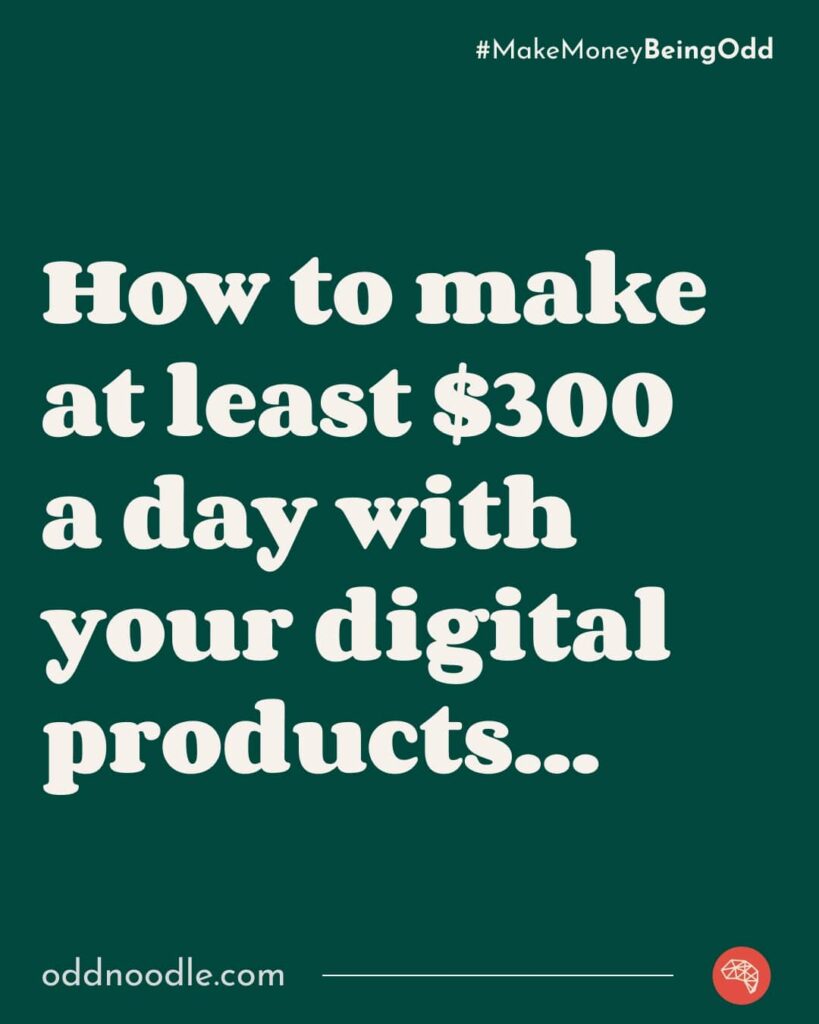It should come as no surprise to let you know that our favorite way of making money is by sending out emails. Of course, that makes it seem like we sit at our computer writing emails every single day and that isn’t the case.
In fact, we probably only spend 45 days a year writing emails and that sets us up for the whole year to be able to sell our digital products every single day.
But a lot of Creators are scared to send emails because they don’t want to be annoying and we get that. If you don’t want to be annoying then sending fewer emails isn’t going to change anything.
If you don’t want to be annoying then the best thing that you can do is send emails that aren’t annoying.
Sounds simple right? Well, it should be but so many people fail at this because they don’t follow these email marketing best practices.
So if you’re interested in writing emails for money then this is the post for you. Because if you just want to send emails to make new friends then your best bet is to find a pen pal.

It Starts Before You Send the First Email
One of the reasons why people struggle with sending amazing emails is that they don’t do a lot of the heavy legwork before they send their first email.
What does this mean?
Your goal is to craft amazing content that people will consume so that when they do decide to sign up for your mailing list, it feels like a no-brainer to want to read your emails.
You want to get people excited when you enter their inbox but this is a problem in today’s world where people are trying their best to get you to sign up for a newsletter without giving much upfront value.
This post is a great example or a terrible one depending on how you feel about it. If it helps you send better emails then you might be enticed to sign up for our mailing list (depending on what opt-in you come across) and learn more about building an online business.
But if you came to this site and the only thing you came across was a signup form then the appeal of reading the emails drops. In fact, you might be hard-pressed to remember who we even are when we do appear in your inbox.
Be Selective
Building a solid email is just as much about keeping people out as it is about letting people in.
No gatekeeping!
That’s not what we are talking about here. What we’re saying is that there are people who just won’t be a good fit for your emails. For example, sometimes we curse in our emails to help get a point across.
And it’s how we talk.
But some people don’t appreciate that so we must show as much of our personalities as we can before people sign up so they understand what they are signing up for.

Crafting Effective Email Campaigns
When it comes to crafting effective email campaigns, there are several key elements you need to consider. From personalized subject lines to compelling email copy, each component plays a crucial role in engaging your audience and driving conversions. Let’s delve into these essential aspects and explore how they can elevate your email marketing game.
Personalized Subject Lines
The subject line of your email is like a virtual handshake, the first impression that entices recipients to open your message. To make it truly captivating, consider personalization. By addressing your subscribers by name or tailoring the subject line to their interests, you can establish a sense of connection and relevance. Personalization not only grabs attention but also gives your emails a human touch.
Compelling Email Copy
Once your subject line has successfully lured your readers in, it’s essential to have compelling email copy that keeps them engaged. Your email copy should be concise, yet persuasive. Craft a captivating story that resonates with your audience and highlights the value of your digital products. Use a language that is easy to understand and relatable, showcasing the benefits your products offer. Remember, the goal is to inspire action and prompt your readers to take the next step.
Clear Call to Action
A clear call to action (CTA) is the guiding light that directs your subscribers towards the desired action. Whether it’s making a purchase, signing up for a trial, or downloading an e-book, your CTA needs to be crystal clear. Use action-oriented words and phrases that compel your readers to act. Place the CTA prominently within your email and make it visually appealing to grab attention. By removing any ambiguity, you create a seamless path for your subscribers to follow.
Mobile-Friendly Design
In a digitally connected world, it’s imperative that your emails are mobile-friendly. With the majority of people accessing their emails on smartphones and tablets, it’s crucial to optimize your email design for different screen sizes. Ensure that your emails are responsive, with easy-to-read fonts, clear images, and a layout that adapts seamlessly to different devices. By providing a seamless mobile experience, you increase the chances of your subscribers engaging with your content.
A/B Testing
To truly optimize your email campaigns, you need to embrace the power of A/B testing. This method involves creating two versions of an email, with slight variations in elements like subject lines, email copy, or CTAs. By sending these variations to different segments of your audience, you can gauge which version performs better in terms of open rates, click-through rates, and conversions. A/B testing allows you to fine-tune your email content and strategy, ensuring you continually improve your results.
Crafting effective email campaigns requires a delicate balance of creativity, data-driven insights, and a deep understanding of your target audience. By incorporating personalized subject lines, compelling email copy, clear calls to action, mobile-friendly design, and A/B testing, you can enhance the effectiveness of your email marketing efforts. So, go ahead and put these strategies into action to drive higher engagement and boost your digital product sales.
Continue reading: If you’re interested in exploring the best tools and platforms for email marketing, check out our detailed guide on email marketing platforms.
Segmentation and Targeting
Imagine you’re at a restaurant and you tell the server that you do not like fish and then the server proceeds to tell you all about the fish special.
You would be turned off and that’s what happens when you don’t segment your list. It becomes a lot easier to sell digital products when you can cater the right message to the right person at the right time.
Your goal is to make them believe that you’re speaking directly to them.
The only reason why we are so effective at building different brands is because we’re good at sending people the messages they have been waiting for.
When we’re talking about The Pocket Business Framework, the idea is to keep the attention of the people who give it to you, but it’s very easy to lose that attention when you start to talk about things that they don’t care about.
Importance of Segmentation
Segmentation involves dividing your email list into distinct segments based on various criteria such as demographics, preferences, purchase history, or engagement level. This segmentation allows you to tailor your email campaigns to the specific needs and interests of each segment, resulting in more personalized and relevant content.
Segmentation is essential because it allows you to send targeted messages that resonate with your subscribers. By sending relevant content, you can capture their attention and build a stronger connection with them. Rather than bombarding your entire list with generic emails, segmentation allows you to deliver the right message to the right people at the right time. This personalized approach can significantly improve open rates, click-through rates, and ultimately drive more conversions.
Grouping Subscribers
To effectively segment your email list, you need to group your subscribers based on specific criteria. This can be done through various methods such as:
- Demographics: Segmenting subscribers based on factors like age, gender, location, or occupation can help you tailor your content to their specific needs and preferences.
- Behavior: Analyzing subscriber behavior, such as past purchases or website interactions, can help you identify different segments and deliver targeted content based on their actions.
- Preferences: Allowing subscribers to express their preferences through preference centers or surveys can help you understand their interests and segment them accordingly.
- Engagement: Segmenting based on engagement level, such as active subscribers versus inactive subscribers, allows you to re-engage inactive subscribers or reward your most engaged ones.
By grouping your subscribers into meaningful segments, you can create more personalized and targeted email campaigns that resonate with their unique characteristics and preferences.
Targeted Content
Once you have segmented your email list, the next step is to create targeted content that aligns with the specific needs and interests of each segment. This involves crafting emails that are tailored to the characteristics of each segment, delivering relevant and valuable information that speaks directly to their desires and pain points.
When creating targeted content, consider the following tips:
- Personalization: Address your subscribers by their names and use personalized subject lines to grab their attention and make them feel valued.
- Relevancy: Ensure that the content you provide is highly relevant to the segment you are targeting. This could include recommending products or services based on their past purchases or providing educational content related to their interests.
- Benefits: Clearly communicate the benefits and value of your digital product in a way that resonates with the specific segment you are targeting. Highlight how your product solves their problems or fulfills their desires.
- Call to Action: Include a clear and compelling call to action that encourages subscribers to take the desired action, such as making a purchase or signing up for a free trial.
By delivering targeted content that speaks directly to the needs and interests of each segment, you can significantly increase engagement and drive conversions.
Segmentation and targeting play a vital role in maximizing the effectiveness of your email marketing campaigns. By dividing your email list into meaningful segments and delivering tailored content, you can engage your subscribers on a deeper level, increase their trust in your brand, and ultimately boost your digital product sales.
Remember, effective segmentation is just one piece of the puzzle. To further enhance your email marketing strategy, be sure to explore the power of email marketing automation and leverage the right email marketing tools to streamline your processes and achieve optimal results.
Automation and Drip Campaigns
Automation and drip campaigns are powerful tools in your email marketing arsenal. These strategies allow you to deliver targeted and timely messages to your subscribers, boosting engagement and driving sales. In this section, we will explore three types of automation and drip campaigns that can take your digital product sales to new heights: welcome emails, abandoned cart emails, and upsell and cross-sell emails.
Welcome Emails
When someone joins your email list, it’s crucial to make a positive first impression. Welcome emails are the perfect opportunity to introduce yourself, set expectations, and deliver value right from the start. This initial touchpoint can significantly impact your subscriber’s perception of your brand and their likelihood of engaging with future emails.
Crafting an effective welcome email involves more than a simple “thank you for subscribing” message. You want to captivate your audience with a compelling subject line that entices them to open the email. Personalization is key here; addressing your subscribers by name creates a sense of connection and reinforces their decision to join your list.
Once they open the email, deliver on the promise of value. This could be exclusive content, a discount code, or access to a free resource. Be sure to include a clear call to action that directs them to take the next step, whether it’s exploring your website, making a purchase, or following you on social media.
Abandoned Cart Emails
Shopping cart abandonment is a common challenge for digital product sellers. However, with the right email marketing strategy, you can recover lost sales and nurture potential customers back into making a purchase. Abandoned cart emails are a powerful tool for re-engaging with these prospects and reminding them of the value they left behind.
To create effective abandoned cart emails, timing is crucial. Send the first email shortly after the abandonment occurs, while the product is still fresh in the customer’s mind. Craft a subject line that sparks curiosity or urgency, enticing them to open the email and revisit their abandoned purchase.
Within the email, remind the customer of the items they left behind and highlight any benefits or incentives that may encourage them to complete the purchase. Consider offering a limited-time discount or free shipping to sweeten the deal. By addressing any concerns or hesitations they may have, you can increase the chances of conversion.
Upsell and Cross-sell Emails
Once a customer has made a purchase, your relationship with them doesn’t have to end there. Upsell and cross-sell emails allow you to continue providing value and maximizing each customer’s lifetime value. These emails leverage the customer’s existing purchase history to recommend complementary or upgraded products that they may find appealing.
When crafting upsell and cross-sell emails, it’s important to focus on relevance and personalization. Segment your email list based on past purchase behavior and send targeted recommendations based on their specific interests. Highlight the benefits and unique features of the recommended products, explaining how they can enhance the customer’s experience or solve additional pain points.
Additionally, consider offering exclusive discounts or bundle deals to entice customers to take advantage of the upsell or cross-sell opportunity. By demonstrating the value and convenience of these complementary products, you can increase both customer satisfaction and your bottom line.
Incorporating automation and drip campaigns into your email marketing strategy is a game-changer for boosting digital product sales. Welcome emails, abandoned cart emails, and upsell and cross-sell emails allow you to engage with your subscribers at key moments, nurturing them towards making a purchase. By leveraging the power of email automation, you can build stronger relationships with your customers and drive meaningful revenue growth.
Continue reading to learn more about email marketing automation and discover the best practices and tools to implement in your campaigns.
Analyzing and Optimizing Email Campaigns
Once you have implemented your email marketing campaigns, it is crucial to analyze and optimize them to ensure they are yielding the desired results. Tracking email metrics, conducting split testing, and continuously improving your strategies are key components in maximizing the effectiveness of your email campaigns.
Tracking Email Metrics
Tracking email metrics provides valuable insights into the performance of your campaigns. By monitoring these metrics, you can gain a deeper understanding of your subscribers’ behavior and preferences, allowing you to refine your approach accordingly. Here are some important email metrics to track:
- Open Rate: This metric measures the percentage of recipients who open your emails. A high open rate indicates that your subject lines are engaging and compelling.
- Click-Through Rate (CTR): The CTR measures the percentage of recipients who click on links within your emails. A high CTR signifies that your email copy and call-to-action buttons are effectively captivating your audience.
- Conversion Rate: The conversion rate represents the percentage of recipients who take the desired action, such as making a purchase or signing up for a service. It is the ultimate measure of success for your email campaigns.
- Bounce Rate: The bounce rate indicates the percentage of emails that did not successfully reach the recipient’s inbox. High bounce rates may signify issues with your email list quality or deliverability.
By closely monitoring these metrics and using email marketing software, you can identify areas for improvement and make data-driven decisions in your campaigns.
Split Testing
Split testing, also known as A/B testing, is an effective method for optimizing your email campaigns. It involves creating two or more variations of an email and sending them to different segments of your audience. By comparing the performance of these variations, you can determine which elements resonate best with your subscribers.
When conducting split tests, it is important to focus on one variable at a time. For example, you could test different subject lines, email designs, or call-to-action buttons. By systematically testing and analyzing the results, you can refine your campaigns and increase their effectiveness over time.
Continuous Improvement
Email marketing is an ever-evolving field, and continuous improvement is crucial for staying ahead of the competition. By staying up-to-date with the latest industry trends and best practices, you can ensure your email campaigns remain relevant and engaging.
Regularly review and analyze the performance of your email campaigns. Take note of what worked well and what could be improved. Experiment with new strategies and techniques, such as personalized content or interactive elements, to keep your subscribers engaged and interested.
Additionally, seek feedback from your subscribers through surveys or customer feedback forms. This valuable input can provide insights into their preferences and help you tailor your email marketing strategies accordingly.
In conclusion, analyzing and optimizing your email campaigns is essential for achieving maximum results. By tracking email metrics, conducting split testing, and continuously improving your strategies, you can enhance the effectiveness of your campaigns and drive higher engagement and conversions.
Remember, success in email marketing is a continuous journey of learning and adaptation. Stay vigilant, stay creative, and reap the rewards of a well-optimized email marketing strategy.
If you’re looking for email marketing platforms, software, templates, or tools to enhance your campaigns, be sure to check out OddNoodle’s resources for a wide range of options to suit your needs.
The 5 Most Effective Email Marketing Best Practices
In today’s digital landscape, email marketing has proven to be a powerful tool for boosting sales of digital products. By following best practices, you can effectively engage with your audience, nurture leads, and convert them into loyal customers.
Building an email list is the first step in any successful email marketing campaign. Utilize opt-in forms on your website to capture valuable contact information from your visitors. Offer enticing lead magnets, such as exclusive content or discounts, to incentivize sign-ups. Create enticing landing pages to encourage visitors to subscribe, and don’t forget to promote your email list on social media platforms to maximize exposure.
Once you have a robust email list, it’s time to craft effective email campaigns. Personalize your subject lines to grab your subscribers’ attention and increase open rates. Write compelling email copy that resonates with your audience and showcases the value of your digital products. Include a clear call to action that directs readers to take the desired action, whether it’s making a purchase or signing up for a webinar. Ensure your emails are mobile-friendly to accommodate the increasing number of users accessing their emails on smartphones. Lastly, don’t underestimate the power of A/B testing to optimize your campaigns and improve results.
Segmentation and targeting are key elements of successful email marketing. By understanding your audience’s preferences and behaviors, you can create targeted content that speaks directly to their needs. Group your subscribers based on demographics, interests, or past purchase behavior, and tailor your emails accordingly. This level of personalization will greatly improve engagement and conversion rates.
Automation and drip campaigns can further enhance your email marketing strategy. Send welcome emails to new subscribers, introducing them to your brand and offering a warm greeting. Utilize abandoned cart emails to remind potential customers of the products they left behind and entice them to complete their purchase. Implement upsell and cross-sell emails to showcase related products and increase average order value. These automated campaigns save you time and effort while driving sales.
To ensure continuous improvement, it’s essential to analyze and optimize your email campaigns. Track important email metrics such as open rates, click-through rates, and conversion rates to gauge the effectiveness of your campaigns. Conduct split testing to compare different elements of your emails and identify what resonates best with your audience. Embrace a mindset of continuous improvement, always seeking ways to refine your strategies and achieve better results.
In conclusion, email marketing is an indispensable tool for boosting sales of digital products. By following the best practices outlined in this article, you can build a strong email list, craft compelling campaigns, segment and target your audience effectively, automate your workflows, and analyze and optimize your results. Embrace the power of email marketing and unlock the full potential of your digital product sales.
If you’re looking for email marketing platforms, email marketing templates, email marketing software, or email marketing tools, be sure to check out OddNoodle’s comprehensive resources to take your email marketing campaigns to the next level.

